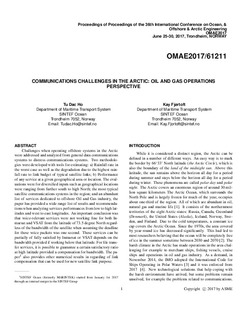| dc.contributor.author | Ho, Tu Dac | |
| dc.contributor.author | Fjørtoft, Kay Endre | |
| dc.date.accessioned | 2018-01-17T17:43:31Z | |
| dc.date.available | 2018-01-17T17:43:31Z | |
| dc.date.created | 2018-01-17T08:31:06Z | |
| dc.date.issued | 2017-06-25 | |
| dc.identifier.citation | ASME 2017 36th International Conference on Ocean, Offshore and Arctic Engineering - Volume 8: Polar and Arctic Sciences and Technology; Petroleum Technology | nb_NO |
| dc.identifier.isbn | 978-0-7918-5776-2 | |
| dc.identifier.uri | http://hdl.handle.net/11250/2478052 | |
| dc.description.abstract | Challenges when operating offshore systems in the Arctic were addressed and analyzed from general data communications systems to distress communications systems. Two methodologies were developed with tools for estimating: a) Rainfall rate in the worst case as well as the degradation due to the highest rainfall rate to link budget of typical satellite links; b) Performance of any service at a given geographical area or location. The evaluations were for diversified inputs such as geographical locations were ranging from further south to high North; the most typical satellite communications systems in the region; and an abundant list of services dedicated to offshore Oil and Gas industry, the paper has provided a wide range list of results and recommendations when analyzing services performances from low to high latitudes and west to east longitudes. An important conclusion was that voice-relevant services were not working fine for both Inmarsat and VSAT from the latitude of 73.5 degree North regardless of the bandwidth of the satellite when assuming the deadline for these voice packets was one second. These services can be partially of fully satisfied by Inmarsat or VSAT depends on the bandwidth provided if working below that latitude. For file transfer services, it is possible to guarantee a certain satisfactory ratio at high latitude provided a compensation for bandwidth. The paper1 also provides other numerical results in regarding of link compensation that can be used for new satellite link purpose. | nb_NO |
| dc.language.iso | eng | nb_NO |
| dc.relation.ispartof | ASME 2017 36th International Conference on Ocean, Offshore and Arctic Engineering - Volume 8: Polar and Arctic Sciences and Technology; Petroleum Technology, Trondheim, Norway, June 25–30, 2017 | |
| dc.relation.ispartofseries | ASME Digital colletion;OMAE2017-61211 | |
| dc.rights | Attribution-NonCommercial-NoDerivatives 4.0 Internasjonal | * |
| dc.rights.uri | http://creativecommons.org/licenses/by-nc-nd/4.0/deed.no | * |
| dc.title | Communications Challenges in the Arctic: Oil and Gas Operations Perspective | nb_NO |
| dc.type | Chapter | nb_NO |
| dc.description.version | acceptedVersion | nb_NO |
| dc.rights.holder | the authors | nb_NO |
| dc.identifier.doi | 10.1115/OMAE2017-61211 | |
| dc.identifier.cristin | 1544863 | |
| cristin.unitcode | 7566,7,0,0 | |
| cristin.unitname | Maritim | |
| cristin.ispublished | true | |
| cristin.fulltext | postprint | |
| cristin.qualitycode | 1 | |

